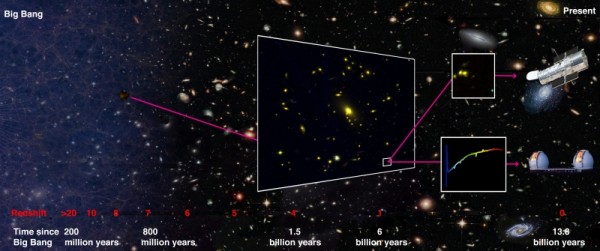By Ana Verayo, | April 12, 2017

Graphic illustration of how MACS1423-z7p64 was detected via gravitational lensing with NASA’s Hubble Space Telescope and confirmed by W. M. Keck Observatory’s MOSFIRE. (NASA)
Astronomers have detected one of the first and faintest galaxies ever found from the early universe. Thanks to the Hubble Space Telescope, this galaxy appears only a few pixels, revealing how it looked like 13.1 billion years ago, some 700 million years after the Big Bang event.
This discovery can provide a better understanding about how the universe evolved and how the first light shined across the cosmos. After around a billion years after the Big Bang, the light emitted by the earliest stars and galaxies ionized hydrogen atoms can still be seen. This resulted in charged plasma that illuminated dark, neutral hydrogen gas, and created the dazzling universe today.
Like Us on Facebook
According to the co-author of the study, Michele Trenti from the University of Melbourne, these faint galaxies are the most commonly found in the universe and were the major driving forces of this crucial cosmic re-ionization process.
According to the lead author of the study, Austin Hoag from the University of California, Davis, this newly discovered galaxy is known as MACS1423-z7p64. It is 10 times more faint than other galaxies and is estimated to host around 500 million stars.
"Our Milky Way galaxy is home to about 100 billion stars which means that this very old and very faint galaxy is 200 times smaller than our own galaxy," Trenti explained. This discovery also means that this type of ancient galaxy can become very challenging to observe using current, powerful telescopes.
Today, the smallest galaxies only contain 1 million stars which means that there is still more discoveries to unravel such as less luminous galaxies as telescope technology evolves. With the help of the Hubble Space Telescope and the Keck Observatory in Hawaii, astronomers were able to confirm this discovery.
Using a technique known as gravitational lensing, the team was able to locate and identify this very distant galaxy. Hoag says that this occurs when the galaxy your are targeting is hidden behind a very massive cosmic structure or cluster of galaxies. Since the galaxy is obscured from view, the light from this galaxy becomes warped and cause the galaxy to appear magnified.
With the help of the Keck Observatory, astronomers were able to determine the precise distance of this galaxy by analyzing the light spectrum emitted by this galaxy. Trenti explained that this light was traveling throughout an expanding universe and shifted to a red wavelength. This means that its light was emitted when the universe was only 700 million years old.
This new study was published in the journal Nature Astronomy.
-
Use of Coronavirus Pandemic Drones Raises Privacy Concerns: Drones Spread Fear, Local Officials Say

-
Coronavirus Hampers The Delivery Of Lockheed Martin F-35 Stealth Fighters For 2020

-
Instagram Speeds Up Plans to Add Account Memorialization Feature Due to COVID-19 Deaths

-
NASA: Perseverance Plans to Bring 'Mars Rock' to Earth in 2031

-
600 Dead And 3,000 In The Hospital as Iranians Believed Drinking High-Concentrations of Alcohol Can Cure The Coronavirus

-
600 Dead And 3,000 In The Hospital as Iranians Believed Drinking High-Concentrations of Alcohol Can Cure The Coronavirus

-
COVID-19: Doctors, Nurses Use Virtual Reality to Learn New Skills in Treating Coronavirus Patients







